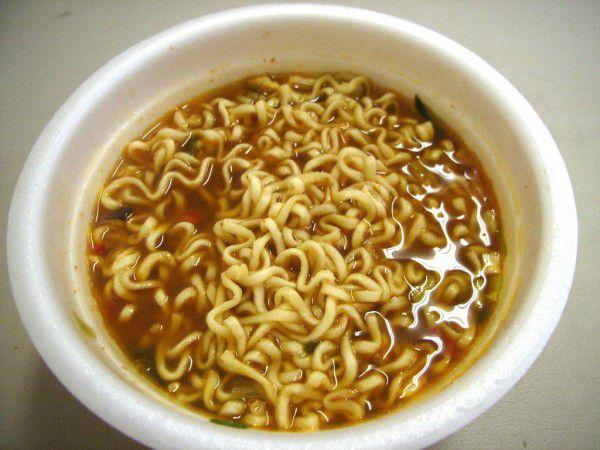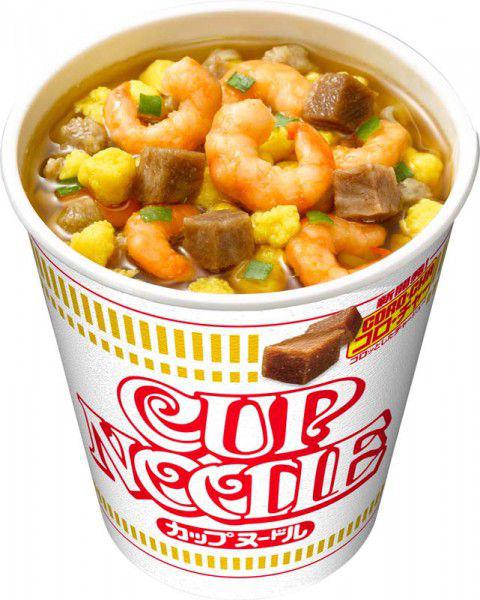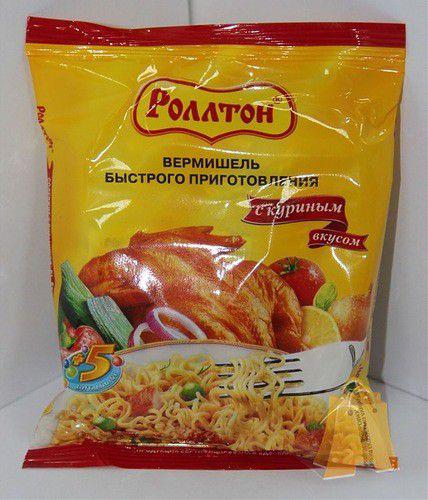1178
The history of instant noodles
The modern pace of life dictates its own rules, including in the diet. A constant lack of time has contributed to the emergence of the Russian and western markets, fast food. The most bought and popular among the people has become a commodity firms' Rollton "and" Doshirak "proved to be a good side. Eat "Doshirak" and "Rollton" consumers, regardless of their social status and food preferences. Fast food products help to save time spent on cooking daily meals and help to avoid supply dry rations. Fast food products will be useful not only during the lunch break at work, but also on the march, a long trip in the country. However, "Rollton" and "Doshirak" many people use in everyday life. Curiously, produktom- noodles in the Russian market began to noodle "Doshirak" company from Korea Korea Yakult, which has received wide popularity due to a strong advertising campaign. But Russian companies do not have to wait long and created a competitive brand "Rollton". Total sales of both leaders is about 37% of the total market sales of instant products.
However, these brands in many countries are not represented, despite the fact that very different types of noodles is very popular under the common international name for instant noodles - Instant Ramen. However, not many people have heard about the history of its creation. But it is nevertheless very exciting.

Who invented noodles ramen noodles?
The origins of mankind instant noodles are in medieval China. Suffice economically favorable situation in the country, has created an impetus to develop new tastes and flavors of food. This process has not bypassed and the traditional Chinese dish - noodles.
In various places in this period we have created new kinds of noodles, which in the future will be the main specialties of each province. Among all species, created when the noodles, the most unique was the «E-Fu Noodles" from Yangzhou (Jiangsu), or it is also called "Yui Noodles» (Yi), on behalf of the chef learned Yui Bindzhou (Yi Bingshou ), it has created.
Yui experimented with noodles, and invented the first fry it in oil, then dried, so that he could keep it longer and cook the noodles in the water later, just before serving. To be precise, this noodle was not fast food, but rather a long-term storage, if not for one side effect of frying in oil, to be exact - is the ability to have it raw, crackling like a modern chips. In this respect, it really was one of the first fast - food outlets. But we must pay tribute Bindzhou he first started to fry in oil product itself, namely the technology became the basis for the creation of instant noodles in the future. And, nevertheless, noodles E-Fu, was a product of accelerated cooking, because all it takes cooking just before serving, did not have to knead and roll the dough to pull itself noodles in front of her cooking, but simply thrown into the boiling water and cook.

Yes, for the inhabitants of the 21st century, it is not fast, but then it was a revolution. But it took four centuries to build the product, really fast food. Then the initiative to create passes in the Japan.
In 2000, among people in Japan conducted a survey to find out what the Japanese invention of the twentieth century, the Japanese themselves as the greatest, which is quite unanimously recognized noodles Ramen noodles. Creator of "instant noodles" called Momofuku Ando. Despite the fact that now it is hard to believe, but to develop their culinary invention, he fought for many years, and the task he set himself was neither more nor less, and the solution to the problem of world hunger.
In 1945, after the surrender of Japan, Ando was in his hometown of Osaka. Looking at the consequences of the destruction was not easy to remain optimistic. Air attacks have caused great damage to the city, was destroyed by a huge number of buildings, including two office buildings and a factory that had been built by him. It was while strolling through the city, he saw people lining up at the improvised stands Ramen and wait patiently.

For many more years after the war, the Japanese continued to suffer from lack of food. Until 1957 Ando was to senior posts after the war he became president of a major bank. However, in 1957 the bank went bankrupt and Ando is not only out of work, but also suffered from oppressive guilt. His thoughts went back to how to solve the problem of its starving citizens. He believed that in the whole world, "the world will come when all people will have enough food».
It was then that he remembered the people who stood in line after the war for a bowl of ramen noodles. He began work on the transformation of the familiar and favorite dishes of noodles in a miracle product, it sootvetvuyuschy originally invented criteria. The task was to make a dish that would be: tasty, never spoiled, it was ready within a couple of minutes and cheap.
Within a year, he tried to think of a suitable way of drying noodles, but nothing worked. Cooked noodles as a result did not have the desired texture or taste. They say that almost casually, he omitted some noodles into the hot oil, which his wife prepared for the upcoming dinner. The result was excellent: Noodles wherein the method is not only dried, but also in addition became slightly porous. This gave the desired effect in the later maceration with hot water.

Momofuku Ando at that time was 48. His career has taken an unexpected turn: he became an inventor and manufacturer of specialties, who later became a symbol of inspiration for Japan. Finally, he could feel some sort of atonement for muchivshuyu its responsibility to investors to splurge. Japanese industry has developed rapidly, and noodles came in very handy to feed the poor working class.
First, though, the Japanese public was inclined to consider a new amazing noodles as a luxury product. First she appeared in ordinary cafes selling ramen and sell it at a price that even exceeds the value of the original "long" noodle.
But it is certainly not in line with the plan Ando. He came up with cheap food, but not amusing snack for the rich. Soon people realized that the noodles are really cheap and easy to prepare and its sales in supermarkets have started to grow rapidly. Gradually appeared on the market and other manufacturers, and the Ando continued to march across the planet, hoping to get closer to the creation of "peace in the world».

The company Ando "Nishino" was to promote the invention of the US market. While in America, Ramen noodles did not enjoy popularity outside of immigrant communities, and especially the Americans did not know how to use chopsticks, which traditionally eat noodles. It was decided that the noodles are easily able to eat and a fork, and it was released to the market under the name "PF Udlz Nudlz».
Sales of the noodles in the US were not particularly high. Noodles while different from that to which we are accustomed. It was not enough simply to add water, it was necessary to cook it for 2-3 minutes. Besides the name in Russian resembles something like "A lot of tasty Lapshichki" only rhymes. As a result, the noodles are particularly popular among the main target audience - men.
During his working trip to America in 1966, Ando noted that the heads of the supermarket, selling it is used as a noodle dishes washed disposable foam cups of coffee from under. They used them simply because other dishes were not, however, Ando came to mind, it's a great idea to improve its product. The subsequent development took as much as 5 years.
And so, in 1971 the US market was released this new, improved version of noodles, called "Cap Nudlz" - "Cup Noodle". It was enough just noodles with boiling water and pour in a few minutes it is ready to eat at. This time was an instant success. Noodles in a cup gives people a very unique opportunity to get a hot meal in a few minutes, without having access to the kitchen and not knowing how to cook. All this with just a cup of hot water.

Later, Ando also developed a special noodles for astronauts that could be * as used in weightlessness that does not spill through the thick broth and did not need hot water, thanks to a miniature noodles.
Momofuku Ando died in 2007, and the ceremony of farewell to him come so many people that we had to arrange it in a football stadium. Momofuku Noodle and became a symbol of rebirth after the war and the Japanese consider him as their national hero. He lived to be 96 years old, and continued to visit their factories to talk to the workers up to the day before his death, despite the fact that at this moment for two years now officially retired. Ando has developed a whole philosophy in connection with the experience of the inventor of noodles. Its basis is the view that "people mistakenly think that they can achieve everything, if you remove all the obstacles in their way." In fact, the obstacles and difficulties this is what motivates us to seek solutions to problems.
Currently noodles is very popular around the world as food for students who have ever little money and who also did not really know how to cook. Sales of soluble noodles all over the world make up more than 94 billion pieces per year.

The city Yakogama in Japan there is a museum dedicated to the invention Ando, which was built in 1994. Its territory was created by a full sized mock-up streets of Tokyo times in 1958 - the year of the invention of noodles.
And in New York in 2004 it was even opened a restaurant called Ramen noodles Momofuku Noodle Bar, which has become one of the most fashionable establishments of the year. Turn on your table there was stretched on for months in advance.
China, including Hong Kong, out of 101, sold 4 billion servings of instant noodles in the world over the last year, "ate" 44 billion - these are the results of a study by the World Association of instant noodles, based in Japan. Photographer EPA Shepard Zhou decided to consolidate this fact with the picture story factory in Wuhan.
Technology of production of instant noodles consists of several stages: kneading flour of special wheat varieties, production of thin pasta, heat steaming, drying, roasting, and final phase - packaging.
Complete lines for the production of instant noodles can fully automate the process of preparing noodle dough from the stage to the packaging of finished products.

The process begins with the filing of a special equipment (vertical kneader) flour and salt water thus kneaded dough. Next is reeling and cutting test. Special equipment allows make-rollers, cutting and forming of "wave" noodles. Within 10 minutes, formed noodles served in a steam tunnel for cooking.
The next stage of the brewing process and molding. The steam tunnel passes noodles heat treatment at a temperature 95-1000`S. Then, cut and formed on the set sizes. Settings are controlled by infrared rays.

Roasting and drying are carried out as special equipment. It consists of a main body, a heat exchanger, circulation pump oil filters and oil containers. Frying in palm oil at 140-1500`S can quickly evaporate excess moisture.
Further, in the cooling tunnel finished noodles air stream is cooled to a normal temperature and is supplied to the packaging.
The packaging process is controlled by infrared rays. Noodles automatically packaged. The equipment allows us to produce and pack noodles of various sizes and weights.

If "Doshirak" is positioned as a tasty product that is consumed at home as a main dish, and just like the people, the "Rollton" gaining the trust of consumers ever-growing variety of tastes, versatility and low cost of the package. Under the brand name "Doshirak" also created new products: drinks, mashed potatoes. By listening to customers, the company appeared noodles KoYa and more convenient packaging. Do not look not only ways of "promotion" of products, but also their quality yourself. Taste Russian fast food as close to the taste of traditional Russian dishes. You can not say about the company's products KoYa, which is ready to please gourmets and lovers of spicy food. However, it does more or less popular these products compared to other druga.Pomimo noodles "Rollton" also produces and instant mashed and other products, but if you talk about noodles "Doshirak" and "Rollton", the composition of the products is similar. Ingredients and packaging components are identical in both cases, the dried noodles, oil and seasoning. In many respects it depends on the flavor of preservatives and flavorings that are added to the product, to give even more appetizing. Fast food products, such as hearty as usual vegetable and meat food, allowing them to win more and more popularity. Alas, the usefulness of this is not to say out. They contain a lot less healthy and the body veschestv.Lvinaya share of the energy value of noodles "Doshirak" or "Rollton" uglevody.K falls on the way, despite the fact that on the label of beautiful natural products, meat "Doshirak" and "Rollton" no. Buyer can eat soy "meat" from the Korean manufacturer, alas, not all of it will be enjoyed.

"Rollton" preferable for our compatriots that at low cost it has excellent kachestvom.Otsutstvie excesses in the wrapper and composition like those who are not willing to overpay for upakovku.Potrebiteli loving convenient containers buy "Doshirak." "Rollton" in such Packaging is also there. It is widely believed that the less intense taste noodle Russian reports that it has a minimum of "chemistry". As always, the Russian buyer selects the products of domestic proizvoditelya.V by the Korean company builds plants for the production of noodles "Doshirak" in Russia. What would happen, time will tell.

The battle of two powerful brands "Doshirak" and "Rollton" for the domestic market will continue, as long as marketing specialists monitor conditions in the redistribution of demand for products within the segment of cheap fast food to more expensive and quality, as well as "healthy eating." However, the dangers of artificial additives already done a lot of research and this is the main criterion for those who oppose the fast food. Semis firm steps to enter the market fast food and have all the opportunities for rapid growth and the acquisition of high demand. These actions will lead to a constant improvement in the quality and types of products.

Source:
However, these brands in many countries are not represented, despite the fact that very different types of noodles is very popular under the common international name for instant noodles - Instant Ramen. However, not many people have heard about the history of its creation. But it is nevertheless very exciting.

Who invented noodles ramen noodles?
The origins of mankind instant noodles are in medieval China. Suffice economically favorable situation in the country, has created an impetus to develop new tastes and flavors of food. This process has not bypassed and the traditional Chinese dish - noodles.
In various places in this period we have created new kinds of noodles, which in the future will be the main specialties of each province. Among all species, created when the noodles, the most unique was the «E-Fu Noodles" from Yangzhou (Jiangsu), or it is also called "Yui Noodles» (Yi), on behalf of the chef learned Yui Bindzhou (Yi Bingshou ), it has created.
Yui experimented with noodles, and invented the first fry it in oil, then dried, so that he could keep it longer and cook the noodles in the water later, just before serving. To be precise, this noodle was not fast food, but rather a long-term storage, if not for one side effect of frying in oil, to be exact - is the ability to have it raw, crackling like a modern chips. In this respect, it really was one of the first fast - food outlets. But we must pay tribute Bindzhou he first started to fry in oil product itself, namely the technology became the basis for the creation of instant noodles in the future. And, nevertheless, noodles E-Fu, was a product of accelerated cooking, because all it takes cooking just before serving, did not have to knead and roll the dough to pull itself noodles in front of her cooking, but simply thrown into the boiling water and cook.

Yes, for the inhabitants of the 21st century, it is not fast, but then it was a revolution. But it took four centuries to build the product, really fast food. Then the initiative to create passes in the Japan.
In 2000, among people in Japan conducted a survey to find out what the Japanese invention of the twentieth century, the Japanese themselves as the greatest, which is quite unanimously recognized noodles Ramen noodles. Creator of "instant noodles" called Momofuku Ando. Despite the fact that now it is hard to believe, but to develop their culinary invention, he fought for many years, and the task he set himself was neither more nor less, and the solution to the problem of world hunger.
In 1945, after the surrender of Japan, Ando was in his hometown of Osaka. Looking at the consequences of the destruction was not easy to remain optimistic. Air attacks have caused great damage to the city, was destroyed by a huge number of buildings, including two office buildings and a factory that had been built by him. It was while strolling through the city, he saw people lining up at the improvised stands Ramen and wait patiently.

For many more years after the war, the Japanese continued to suffer from lack of food. Until 1957 Ando was to senior posts after the war he became president of a major bank. However, in 1957 the bank went bankrupt and Ando is not only out of work, but also suffered from oppressive guilt. His thoughts went back to how to solve the problem of its starving citizens. He believed that in the whole world, "the world will come when all people will have enough food».
It was then that he remembered the people who stood in line after the war for a bowl of ramen noodles. He began work on the transformation of the familiar and favorite dishes of noodles in a miracle product, it sootvetvuyuschy originally invented criteria. The task was to make a dish that would be: tasty, never spoiled, it was ready within a couple of minutes and cheap.
Within a year, he tried to think of a suitable way of drying noodles, but nothing worked. Cooked noodles as a result did not have the desired texture or taste. They say that almost casually, he omitted some noodles into the hot oil, which his wife prepared for the upcoming dinner. The result was excellent: Noodles wherein the method is not only dried, but also in addition became slightly porous. This gave the desired effect in the later maceration with hot water.

Momofuku Ando at that time was 48. His career has taken an unexpected turn: he became an inventor and manufacturer of specialties, who later became a symbol of inspiration for Japan. Finally, he could feel some sort of atonement for muchivshuyu its responsibility to investors to splurge. Japanese industry has developed rapidly, and noodles came in very handy to feed the poor working class.
First, though, the Japanese public was inclined to consider a new amazing noodles as a luxury product. First she appeared in ordinary cafes selling ramen and sell it at a price that even exceeds the value of the original "long" noodle.
But it is certainly not in line with the plan Ando. He came up with cheap food, but not amusing snack for the rich. Soon people realized that the noodles are really cheap and easy to prepare and its sales in supermarkets have started to grow rapidly. Gradually appeared on the market and other manufacturers, and the Ando continued to march across the planet, hoping to get closer to the creation of "peace in the world».

The company Ando "Nishino" was to promote the invention of the US market. While in America, Ramen noodles did not enjoy popularity outside of immigrant communities, and especially the Americans did not know how to use chopsticks, which traditionally eat noodles. It was decided that the noodles are easily able to eat and a fork, and it was released to the market under the name "PF Udlz Nudlz».
Sales of the noodles in the US were not particularly high. Noodles while different from that to which we are accustomed. It was not enough simply to add water, it was necessary to cook it for 2-3 minutes. Besides the name in Russian resembles something like "A lot of tasty Lapshichki" only rhymes. As a result, the noodles are particularly popular among the main target audience - men.
During his working trip to America in 1966, Ando noted that the heads of the supermarket, selling it is used as a noodle dishes washed disposable foam cups of coffee from under. They used them simply because other dishes were not, however, Ando came to mind, it's a great idea to improve its product. The subsequent development took as much as 5 years.
And so, in 1971 the US market was released this new, improved version of noodles, called "Cap Nudlz" - "Cup Noodle". It was enough just noodles with boiling water and pour in a few minutes it is ready to eat at. This time was an instant success. Noodles in a cup gives people a very unique opportunity to get a hot meal in a few minutes, without having access to the kitchen and not knowing how to cook. All this with just a cup of hot water.

Later, Ando also developed a special noodles for astronauts that could be * as used in weightlessness that does not spill through the thick broth and did not need hot water, thanks to a miniature noodles.
Momofuku Ando died in 2007, and the ceremony of farewell to him come so many people that we had to arrange it in a football stadium. Momofuku Noodle and became a symbol of rebirth after the war and the Japanese consider him as their national hero. He lived to be 96 years old, and continued to visit their factories to talk to the workers up to the day before his death, despite the fact that at this moment for two years now officially retired. Ando has developed a whole philosophy in connection with the experience of the inventor of noodles. Its basis is the view that "people mistakenly think that they can achieve everything, if you remove all the obstacles in their way." In fact, the obstacles and difficulties this is what motivates us to seek solutions to problems.
Currently noodles is very popular around the world as food for students who have ever little money and who also did not really know how to cook. Sales of soluble noodles all over the world make up more than 94 billion pieces per year.

The city Yakogama in Japan there is a museum dedicated to the invention Ando, which was built in 1994. Its territory was created by a full sized mock-up streets of Tokyo times in 1958 - the year of the invention of noodles.
And in New York in 2004 it was even opened a restaurant called Ramen noodles Momofuku Noodle Bar, which has become one of the most fashionable establishments of the year. Turn on your table there was stretched on for months in advance.
China, including Hong Kong, out of 101, sold 4 billion servings of instant noodles in the world over the last year, "ate" 44 billion - these are the results of a study by the World Association of instant noodles, based in Japan. Photographer EPA Shepard Zhou decided to consolidate this fact with the picture story factory in Wuhan.
Technology of production of instant noodles consists of several stages: kneading flour of special wheat varieties, production of thin pasta, heat steaming, drying, roasting, and final phase - packaging.
Complete lines for the production of instant noodles can fully automate the process of preparing noodle dough from the stage to the packaging of finished products.

The process begins with the filing of a special equipment (vertical kneader) flour and salt water thus kneaded dough. Next is reeling and cutting test. Special equipment allows make-rollers, cutting and forming of "wave" noodles. Within 10 minutes, formed noodles served in a steam tunnel for cooking.
The next stage of the brewing process and molding. The steam tunnel passes noodles heat treatment at a temperature 95-1000`S. Then, cut and formed on the set sizes. Settings are controlled by infrared rays.

Roasting and drying are carried out as special equipment. It consists of a main body, a heat exchanger, circulation pump oil filters and oil containers. Frying in palm oil at 140-1500`S can quickly evaporate excess moisture.
Further, in the cooling tunnel finished noodles air stream is cooled to a normal temperature and is supplied to the packaging.
The packaging process is controlled by infrared rays. Noodles automatically packaged. The equipment allows us to produce and pack noodles of various sizes and weights.

If "Doshirak" is positioned as a tasty product that is consumed at home as a main dish, and just like the people, the "Rollton" gaining the trust of consumers ever-growing variety of tastes, versatility and low cost of the package. Under the brand name "Doshirak" also created new products: drinks, mashed potatoes. By listening to customers, the company appeared noodles KoYa and more convenient packaging. Do not look not only ways of "promotion" of products, but also their quality yourself. Taste Russian fast food as close to the taste of traditional Russian dishes. You can not say about the company's products KoYa, which is ready to please gourmets and lovers of spicy food. However, it does more or less popular these products compared to other druga.Pomimo noodles "Rollton" also produces and instant mashed and other products, but if you talk about noodles "Doshirak" and "Rollton", the composition of the products is similar. Ingredients and packaging components are identical in both cases, the dried noodles, oil and seasoning. In many respects it depends on the flavor of preservatives and flavorings that are added to the product, to give even more appetizing. Fast food products, such as hearty as usual vegetable and meat food, allowing them to win more and more popularity. Alas, the usefulness of this is not to say out. They contain a lot less healthy and the body veschestv.Lvinaya share of the energy value of noodles "Doshirak" or "Rollton" uglevody.K falls on the way, despite the fact that on the label of beautiful natural products, meat "Doshirak" and "Rollton" no. Buyer can eat soy "meat" from the Korean manufacturer, alas, not all of it will be enjoyed.

"Rollton" preferable for our compatriots that at low cost it has excellent kachestvom.Otsutstvie excesses in the wrapper and composition like those who are not willing to overpay for upakovku.Potrebiteli loving convenient containers buy "Doshirak." "Rollton" in such Packaging is also there. It is widely believed that the less intense taste noodle Russian reports that it has a minimum of "chemistry". As always, the Russian buyer selects the products of domestic proizvoditelya.V by the Korean company builds plants for the production of noodles "Doshirak" in Russia. What would happen, time will tell.

The battle of two powerful brands "Doshirak" and "Rollton" for the domestic market will continue, as long as marketing specialists monitor conditions in the redistribution of demand for products within the segment of cheap fast food to more expensive and quality, as well as "healthy eating." However, the dangers of artificial additives already done a lot of research and this is the main criterion for those who oppose the fast food. Semis firm steps to enter the market fast food and have all the opportunities for rapid growth and the acquisition of high demand. These actions will lead to a constant improvement in the quality and types of products.

Source:























